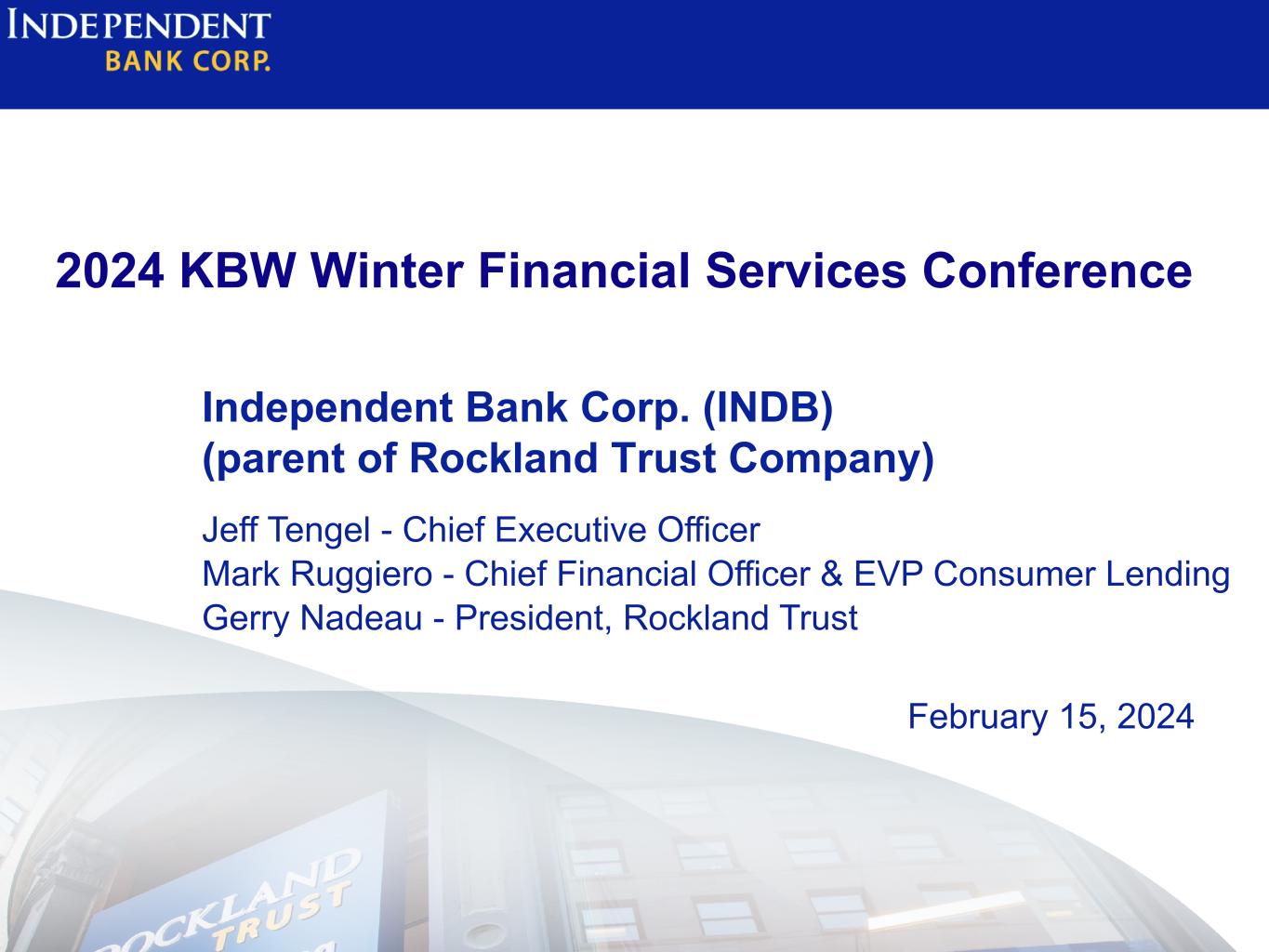
2024 KBW Winter Financial Services Conference Jeff Tengel - Chief Executive Officer Mark Ruggiero - Chief Financial Officer & EVP Consumer Lending Gerry Nadeau - President, Rockland Trust Independent Bank Corp. (INDB) (parent of Rockland Trust Company) February 15, 2024
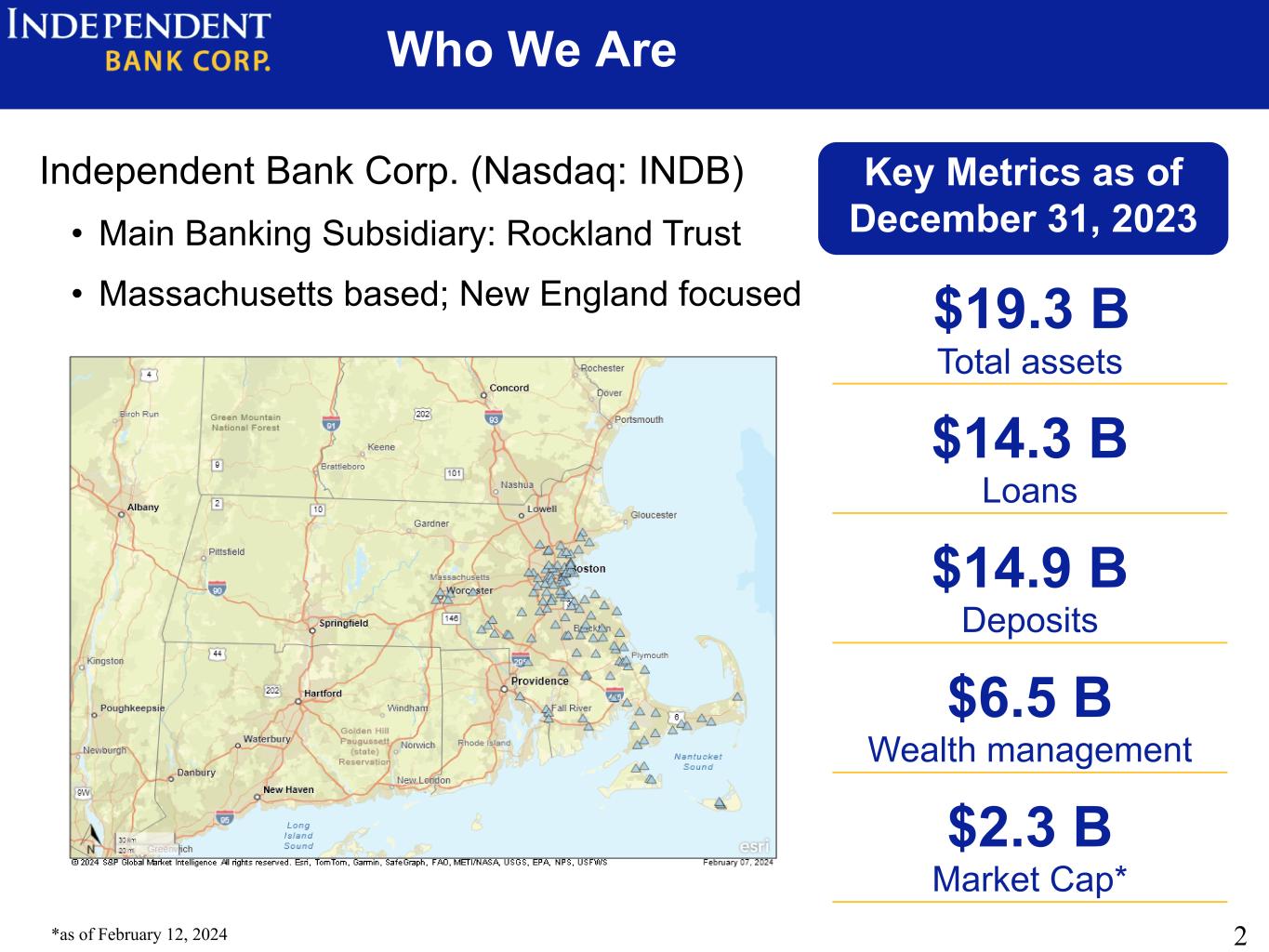
Who We Are Independent Bank Corp. (Nasdaq: INDB) • Main Banking Subsidiary: Rockland Trust • Massachusetts based; New England focused $19.3 B Total assets $14.3 B Loans $14.9 B Deposits $6.5 B Wealth management $2.3 B Market Cap* Key Metrics as of December 31, 2023 2*as of February 12, 2024
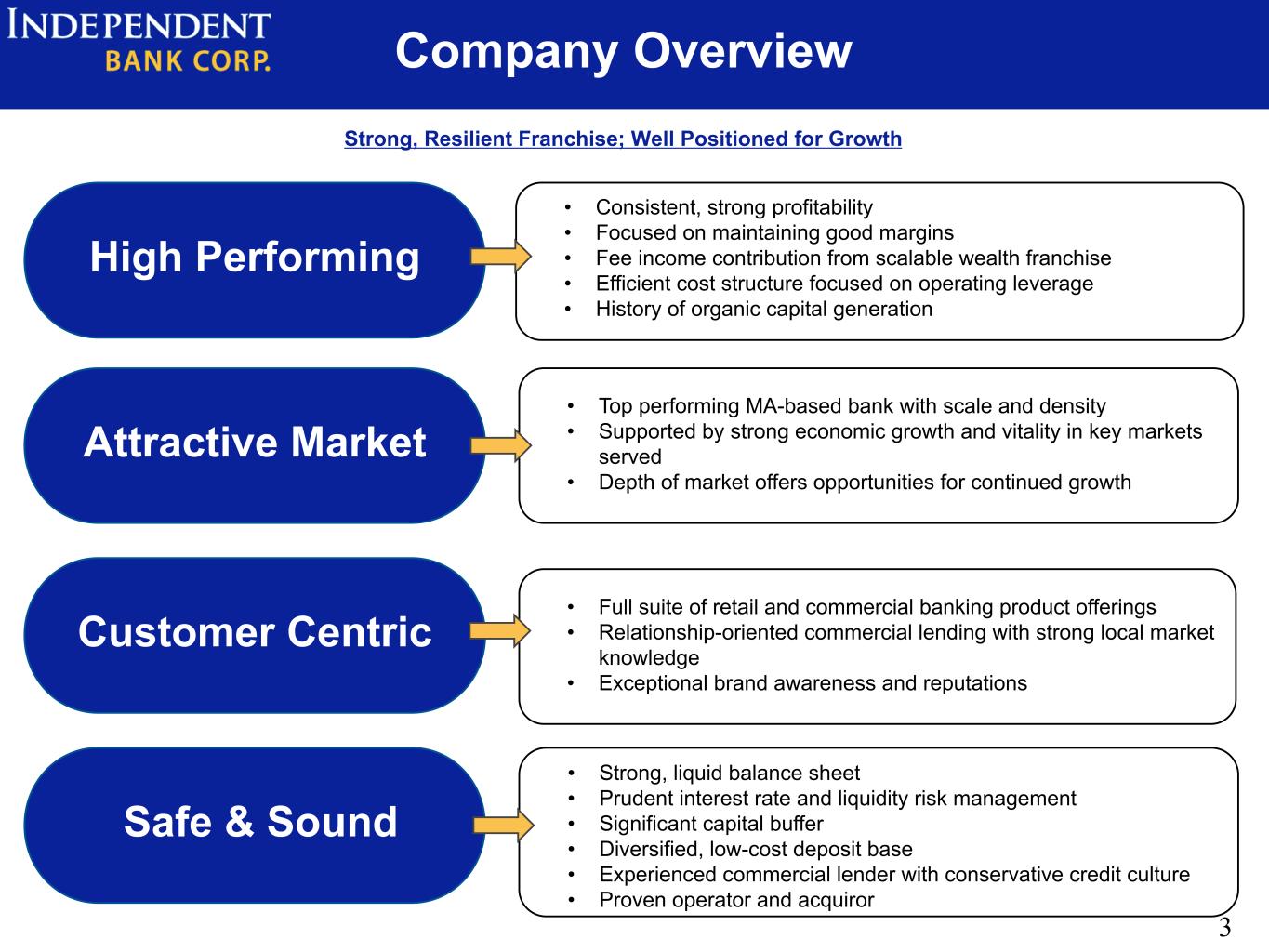
3 Company Overview Safe & Sound Customer Centric • Strong, liquid balance sheet • Prudent interest rate and liquidity risk management • Significant capital buffer • Diversified, low-cost deposit base • Experienced commercial lender with conservative credit culture • Proven operator and acquiror • Full suite of retail and commercial banking product offerings • Relationship-oriented commercial lending with strong local market knowledge • Exceptional brand awareness and reputations Attractive Market • Top performing MA-based bank with scale and density • Supported by strong economic growth and vitality in key markets served • Depth of market offers opportunities for continued growth Strong, Resilient Franchise; Well Positioned for Growth High Performing • Consistent, strong profitability • Focused on maintaining good margins • Fee income contribution from scalable wealth franchise • Efficient cost structure focused on operating leverage • History of organic capital generation

Near-Term Priorities 4 • Sustaining progress under new CEO • Deepening of risk management infrastructure • Robust portfolio management activity in CRE office asset class • Stabilizing interest rate risk through volatile rate environment • Prioritizing liquidity and capital risk management ◦ Focus on deposit generation initiatives • Taking disciplined approach to economic uncertainty • Extending our presence in attractive Worcester and Boston - North markets • Focusing on core relationships • Assessing M&A Landscape • Investing in digital/mobile technology • Facilities optimization, including select openings and closings • Piloting robotic processing solutions in operation areas • Enhanced procurement function/ expense monitoring Balance Sheet Management Efficiency InitiativesGrowth Initiatives Corporate Governance

Source: SNL Financial; Deposit/Market Share data as of June 30, 2023 Expanding Company Footprint Exceptional Deposit Franchise Market Share Rank 2023 % of INDB Deposits Plymouth County 1 25.4% 31% Norfolk County 5 6.6% 15% Suffolk County 8 0.7% 14% Barnstable County (Cape Cod) 3 11.8% 9% Bristol County 5 8.8% 9% Middlesex County 14 1.6% 9% Essex County 11 2.7% 6% Worcester County 16 2.1% 3% Nantucket County 1 35.0% 3% Dukes County (MV) 2 15.1% 1% 5 Disciplined Organic + Acquisition Growth

Operating Earnings ($Mil)** $121.7 $187.6 $268.9 $239.5 $3.66 $5.38 $5.80 $5.42 Operating Earnings Operating EPS 2020 2021 2022 2023 $0 $100 $200 $300 $2 $4 $6 GAAP Earnings ($Mil) $121.2 $121.0 $263.8 $239.5 $3.64 $3.47 $5.69 $5.42 Net Income Diluted EPS 2020 2021 2022 2023 $0 $100 $200 $300 $2 $4 $6 Financial Performance: Strong Fundamentals Drive Long-Term Trends **See appendix B for reconciliation Long-Term Trends • Strong core deposit base • Low funding costs • Robust loan/deposit originations • Low credit loss rates • Asset management growth • Mortgage flexibility • Strong operating efficiency • Accretive acquisitions • Tangible book value focus Current Environmental Factors • Interest rate outlook • Credit conditions • Deposit Flows 6 Operating ROAA ** 0.97% 1.26% 1.35% 1.24% 2020 2021 2022 2023 0.75% 1.00% 1.25% 1.50% Operating ROTCE** 10.42% 14.26%14.14% 12.78% 2020 2021 2022 2023 10.00% 12.50% 15.00%
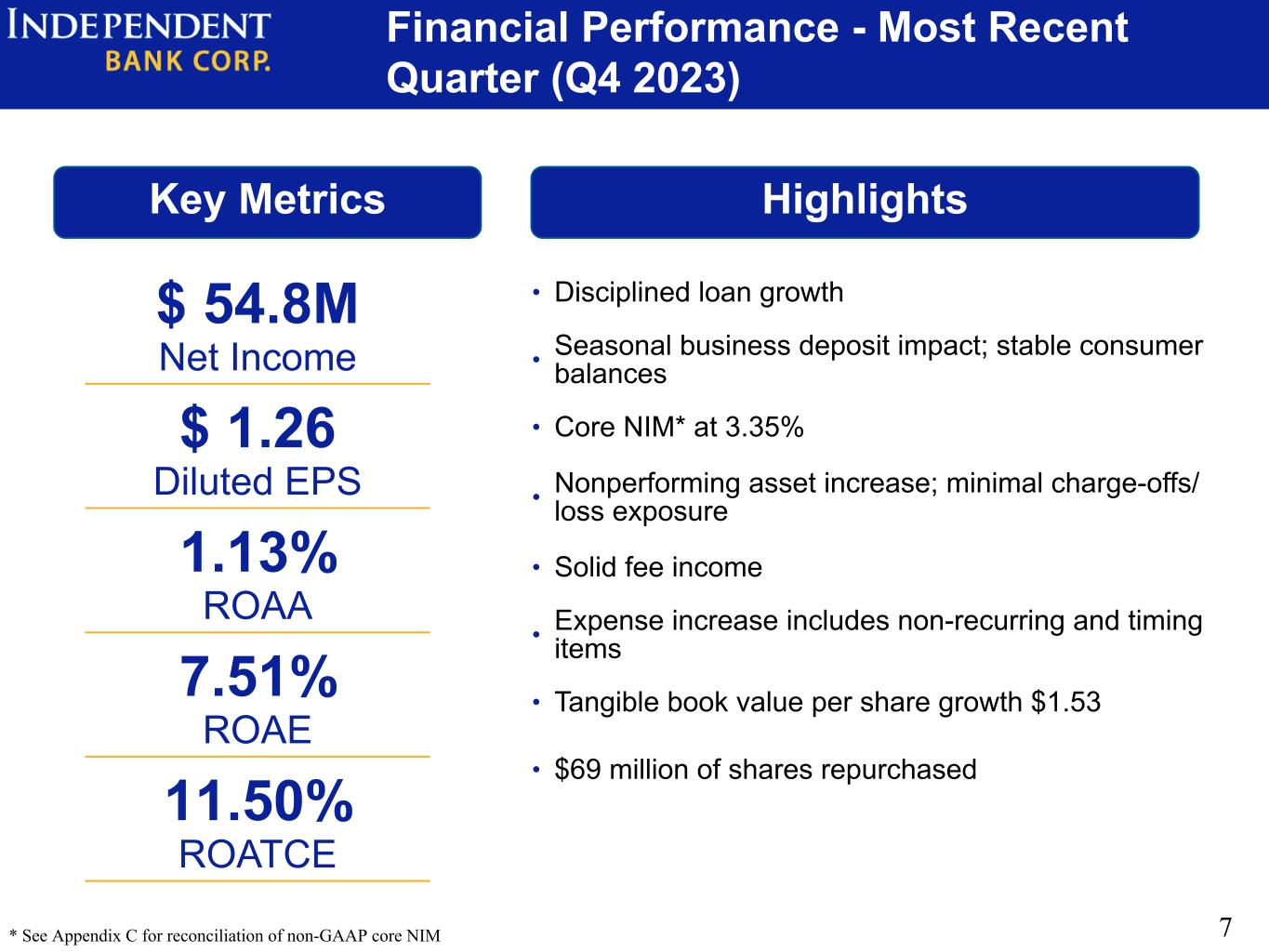
$ 54.8M Net Income $ 1.26 Diluted EPS 1.13% ROAA 7.51% ROAE 11.50% ROATCE 7 Financial Performance - Most Recent Quarter (Q4 2023) • Disciplined loan growth • Seasonal business deposit impact; stable consumer balances • Core NIM* at 3.35% • Nonperforming asset increase; minimal charge-offs/ loss exposure • Solid fee income • Expense increase includes non-recurring and timing items • Tangible book value per share growth $1.53 • $69 million of shares repurchased * See Appendix C for reconciliation of non-GAAP core NIM Key Metrics Highlights

8 Loan Balances ($ in millions) Period Ended $ Increase % Increase Loan Category 12/31/2023 9/30/2023 (Decrease) (Decrease) Commercial and industrial $ 1,580 $ 1,653 $ (73) (4.4) % Commercial real estate 8,041 7,896 145 1.8 % Commercial construction 850 965 (115) (11.9) % Small business 252 245 7 2.9 % Total commercial 10,723 10,759 (36) (0.3) % Residential real estate 2,424 2,338 86 3.7 % Home equity - first position 519 530 (11) (2.1) % Home equity - subordinate positions 579 566 13 2.3 % Total consumer real estate 3,522 3,434 88 2.6 % Other consumer 33 31 2 6.5 % Total loans $ 14,278 $ 14,224 $ 54 0.4 %
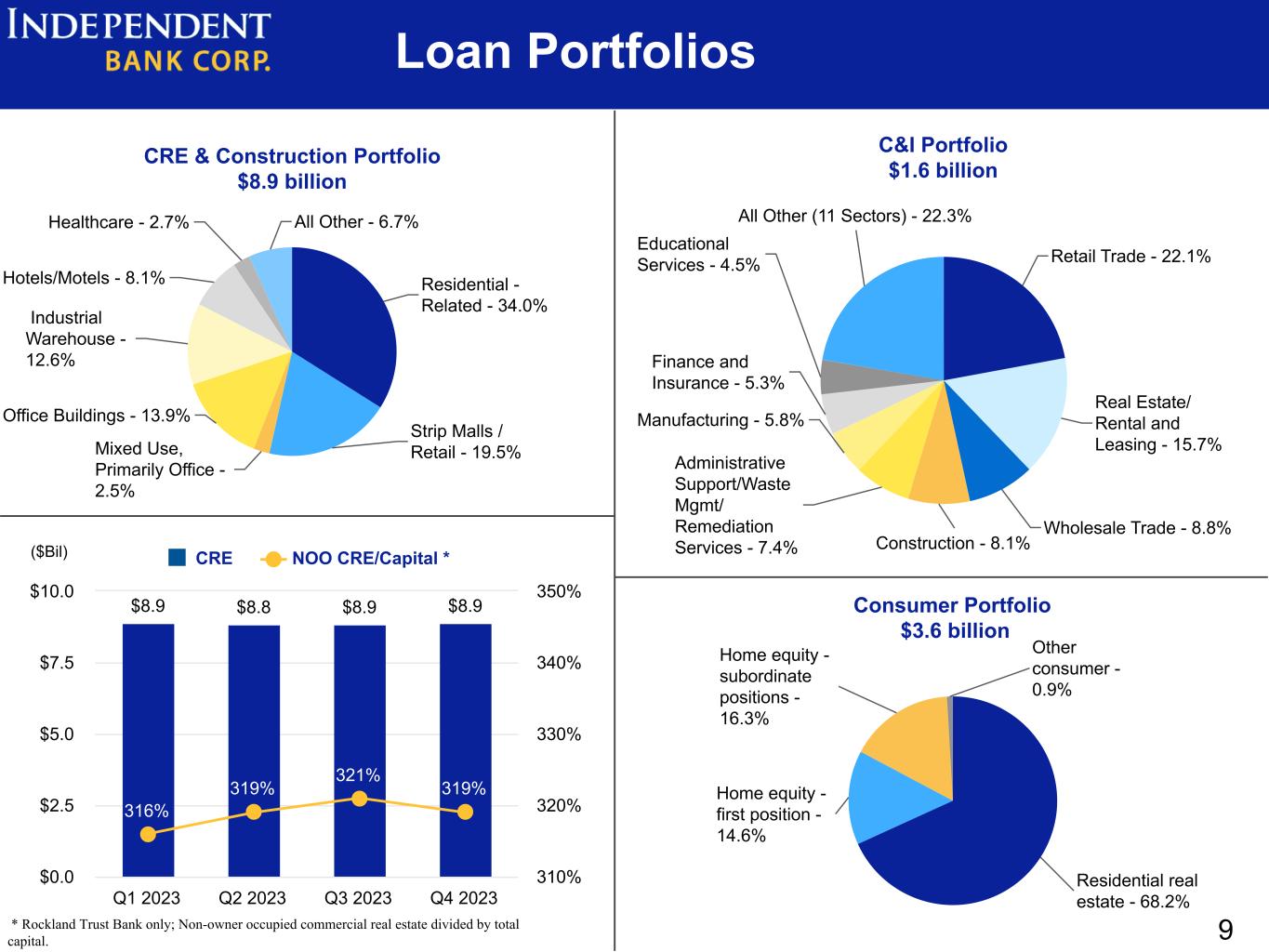
9 Loan Portfolios 95% CRE & Construction Portfolio $8.9 billion Residential - Related - 34.0% Strip Malls / Retail - 19.5%Mixed Use, Primarily Office - 2.5% Office Buildings - 13.9% Industrial Warehouse - 12.6% Hotels/Motels - 8.1% Healthcare - 2.7% All Other - 6.7% C&I Portfolio $1.6 billion Retail Trade - 22.1% Real Estate/ Rental and Leasing - 15.7% Wholesale Trade - 8.8% Construction - 8.1% Administrative Support/Waste Mgmt/ Remediation Services - 7.4% Manufacturing - 5.8% Finance and Insurance - 5.3% Educational Services - 4.5% All Other (11 Sectors) - 22.3% Consumer Portfolio $3.6 billion Residential real estate - 68.2% Home equity - first position - 14.6% Home equity - subordinate positions - 16.3% Other consumer - 0.9% $8.9 $8.8 $8.9 $8.9 316% 319% 321% 319% CRE NOO CRE/Capital * Q1 2023 Q2 2023 Q3 2023 Q4 2023 $0.0 $2.5 $5.0 $7.5 $10.0 310% 320% 330% 340% 350% * Rockland Trust Bank only; Non-owner occupied commercial real estate divided by total capital. ($Bil)

10 Focal Point: Non-Owner Occupied CRE Office (inclusive of construction) 95% CRE Office - Total Portfolio ($ in millions) December 31, 2023 September 30, 2023 CRE - Mixed use, primarily office* $ 219 $ 219 CRE - Office: owner occupied 193 200 CRE - Office: non-owner occupied 1,045 1,060 *CRE - Mixed use, primarily office category includes loans with revenues from office space greater than 50%. Focus Point: Non-owner Occupied CRE Office Asset Quality As of 12/31/2023 Criticized Classified Total Avg. Loan Size $ % $ % ($ in millions) Class A $ 481 $ 12.7 $ 75.0 7.2 % $ 38.5 3.7 % Class B/C 441 2.9 10.0 1.0 % 2.4 0.2 % Medical Office 123 4.7 — — % — — % $ 1,045 $ 4.9 $ 85.0 8.2 % $ 40.9 3.9 % Key Portfolio Characteristics • Primarily Massachusetts based • "Barbell" portfolio ◦ Top 20 loans: Avg balance = $25.8M ◦ All others (193 loans): Avg balance = $2.8M Maturity Schedule Review of Top 20 Loans • $516.1M, or 49.4% of portfolio ◦ $55.3M criticized ◦ $18.5M classified • $305.1M in Class A Category • In general, ~80% occupancy • Loans are actively managed - direct communication with borrowers 2024 2025 2026 2027 2028+ Total ($) 12% 20% 8% 13% 47% $1.045B
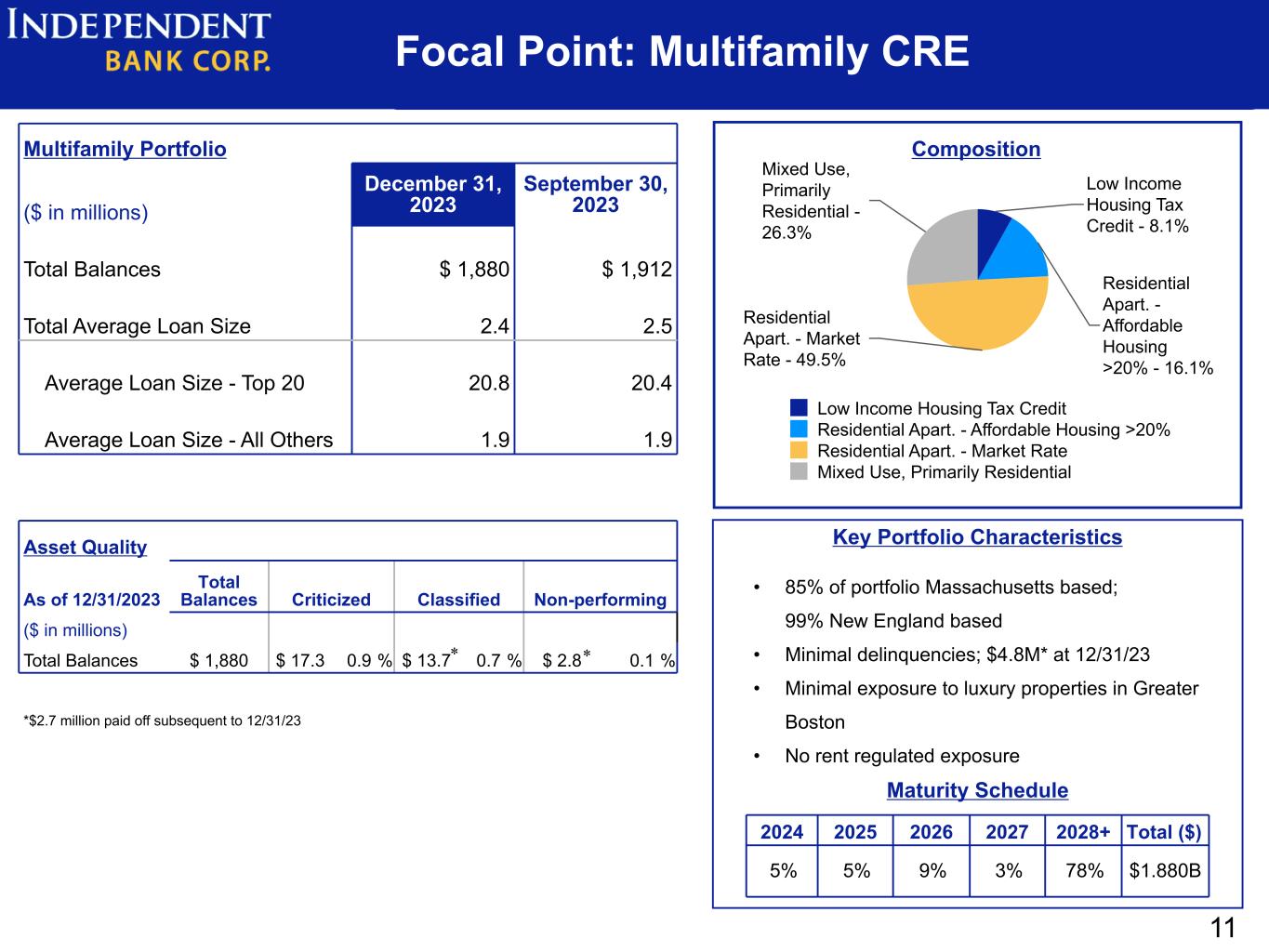
11 Focal Point: Multifamily CRE 95% Multifamily Portfolio ($ in millions) December 31, 2023 September 30, 2023 Total Balances $ 1,880 $ 1,912 Total Average Loan Size 2.4 2.5 Average Loan Size - Top 20 20.8 20.4 Average Loan Size - All Others 1.9 1.9 Asset Quality As of 12/31/2023 Total Balances Criticized Classified Non-performing ($ in millions) Total Balances $ 1,880 $ 17.3 0.9 % $ 13.7 0.7 % $ 2.8 0.1 % *$2.7 million paid off subsequent to 12/31/23 Composition Low Income Housing Tax Credit - 8.1% Residential Apart. - Affordable Housing >20% - 16.1% Residential Apart. - Market Rate - 49.5% Mixed Use, Primarily Residential - 26.3% Low Income Housing Tax Credit Residential Apart. - Affordable Housing >20% Residential Apart. - Market Rate Mixed Use, Primarily Residential Key Portfolio Characteristics • 85% of portfolio Massachusetts based; 99% New England based • Minimal delinquencies; $4.8M* at 12/31/23 • Minimal exposure to luxury properties in Greater Boston • No rent regulated exposure Maturity Schedule 2024 2025 2026 2027 2028+ Total ($) 5% 5% 9% 3% 78% $1.880B **
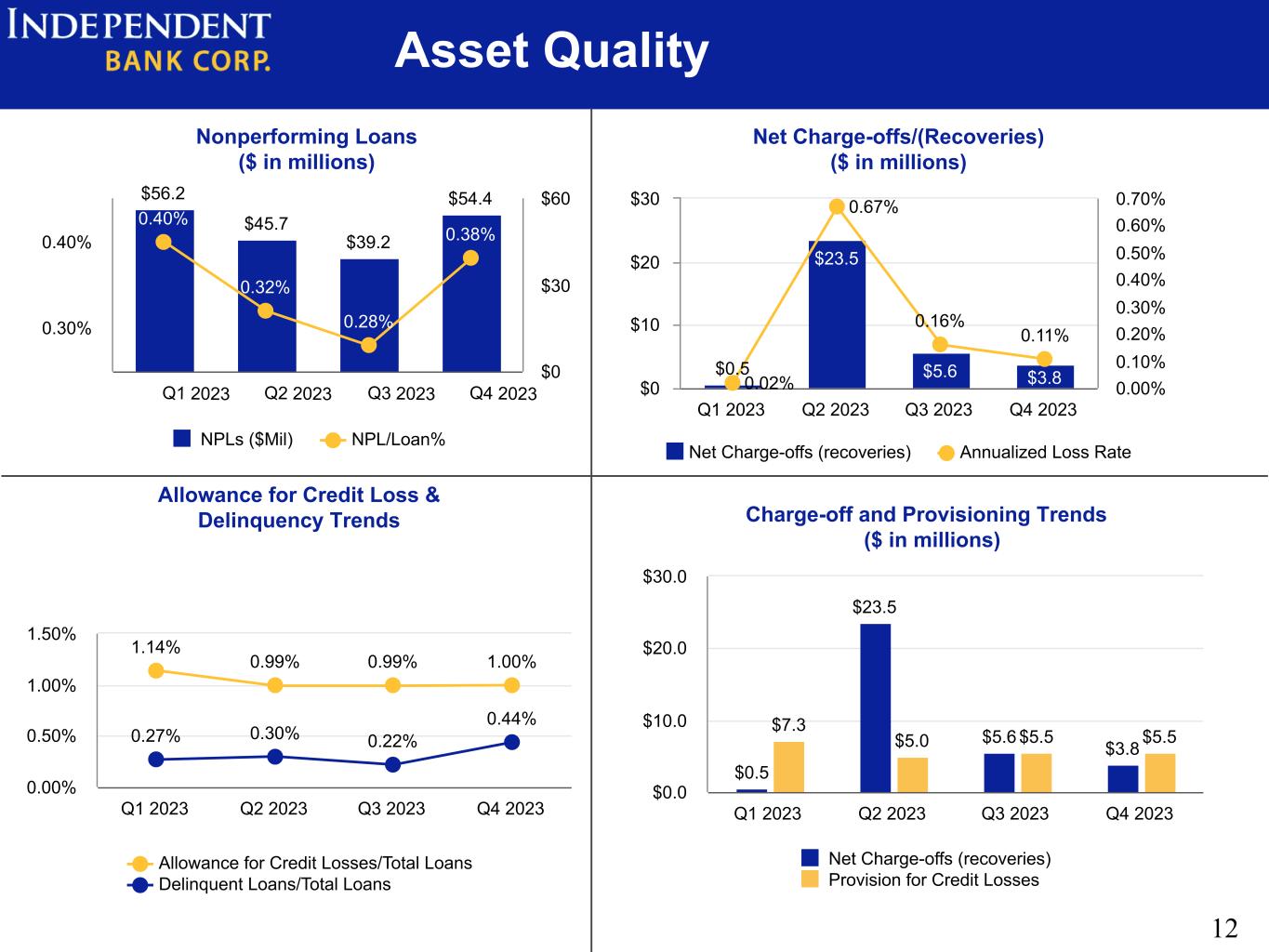
12 Nonperforming Loans ($ in millions) $56.2 $45.7 $39.2 $54.4 0.40% 0.32% 0.28% 0.38% NPLs ($Mil) NPL/Loan% Q1 2023 Q2 2023 Q3 2023 Q4 2023 0.30% 0.40% $0 $30 $60 Net Charge-offs/(Recoveries) ($ in millions) $0.5 $23.5 $5.6 $3.80.02% 0.67% 0.16% 0.11% Net Charge-offs (recoveries) Annualized Loss Rate Q1 2023 Q2 2023 Q3 2023 Q4 2023 $0 $10 $20 $30 0.00% 0.10% 0.20% 0.30% 0.40% 0.50% 0.60% 0.70% Asset Quality Allowance for Credit Loss & Delinquency Trends 1.14% 0.99% 0.99% 1.00% 0.27% 0.30% 0.22% 0.44% Allowance for Credit Losses/Total Loans Delinquent Loans/Total Loans Q1 2023 Q2 2023 Q3 2023 Q4 2023 0.00% 0.50% 1.00% 1.50% Charge-off and Provisioning Trends ($ in millions) $0.5 $23.5 $5.6 $3.8 $7.3 $5.0 $5.5 $5.5 Net Charge-offs (recoveries) Provision for Credit Losses Q1 2023 Q2 2023 Q3 2023 Q4 2023 $0.0 $10.0 $20.0 $30.0
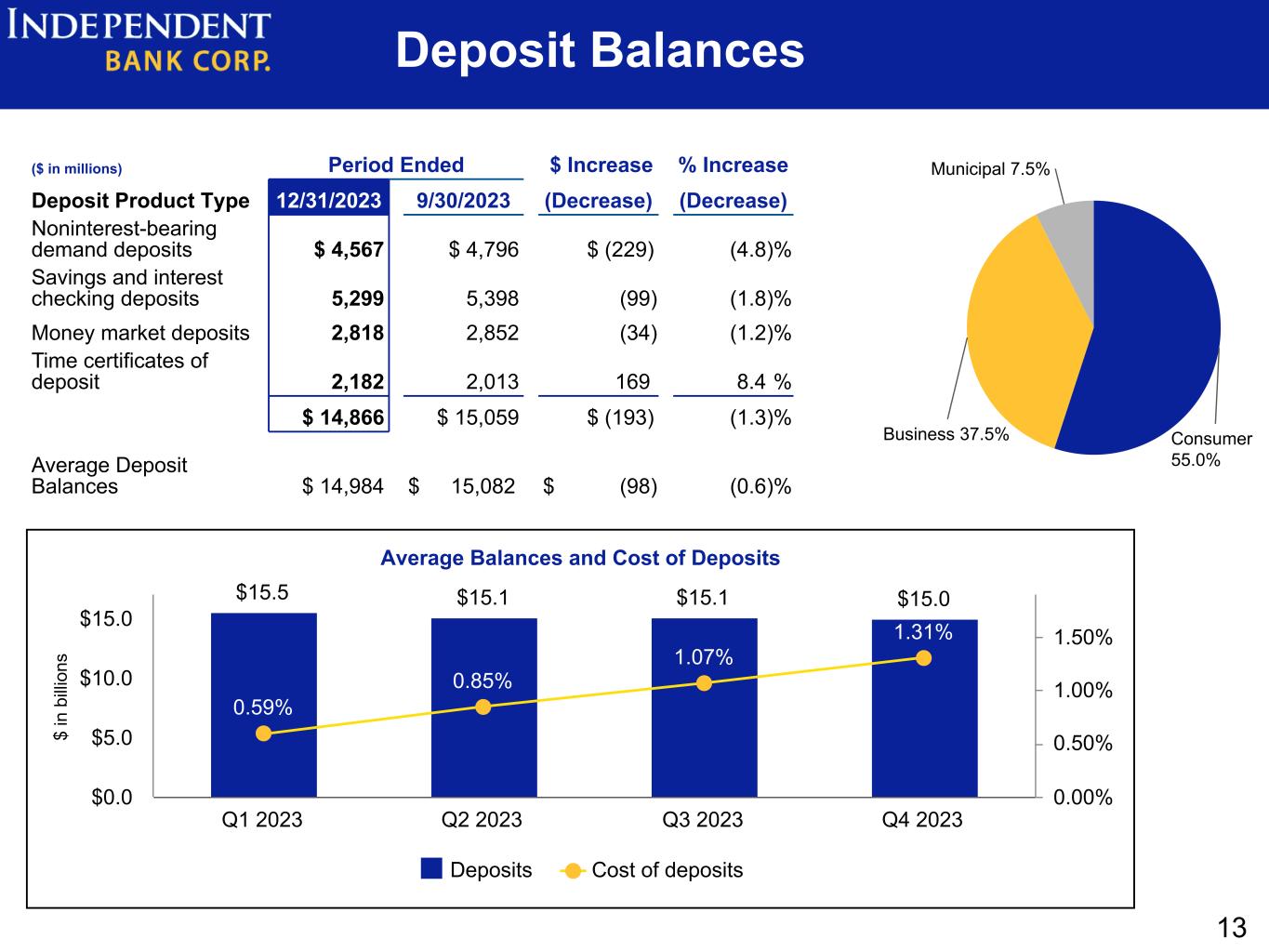
13 ($ in millions) Period Ended $ Increase % Increase Deposit Product Type 12/31/2023 9/30/2023 (Decrease) (Decrease) Noninterest-bearing demand deposits $ 4,567 $ 4,796 $ (229) (4.8) % Savings and interest checking deposits 5,299 5,398 (99) (1.8) % Money market deposits 2,818 2,852 (34) (1.2) % Time certificates of deposit 2,182 2,013 169 8.4 % $ 14,866 $ 15,059 $ (193) (1.3) % Average Deposit Balances $ 14,984 $ 15,082 $ (98) (0.6) % Deposit Balances $ in b ill io ns Average Balances and Cost of Deposits $15.5 $15.1 $15.1 $15.0 0.59% 0.85% 1.07% 1.31% Deposits Cost of deposits Q1 2023 Q2 2023 Q3 2023 Q4 2023 $0.0 $5.0 $10.0 $15.0 0.00% 0.50% 1.00% 1.50% Consumer 55.0% Business 37.5% Municipal 7.5%
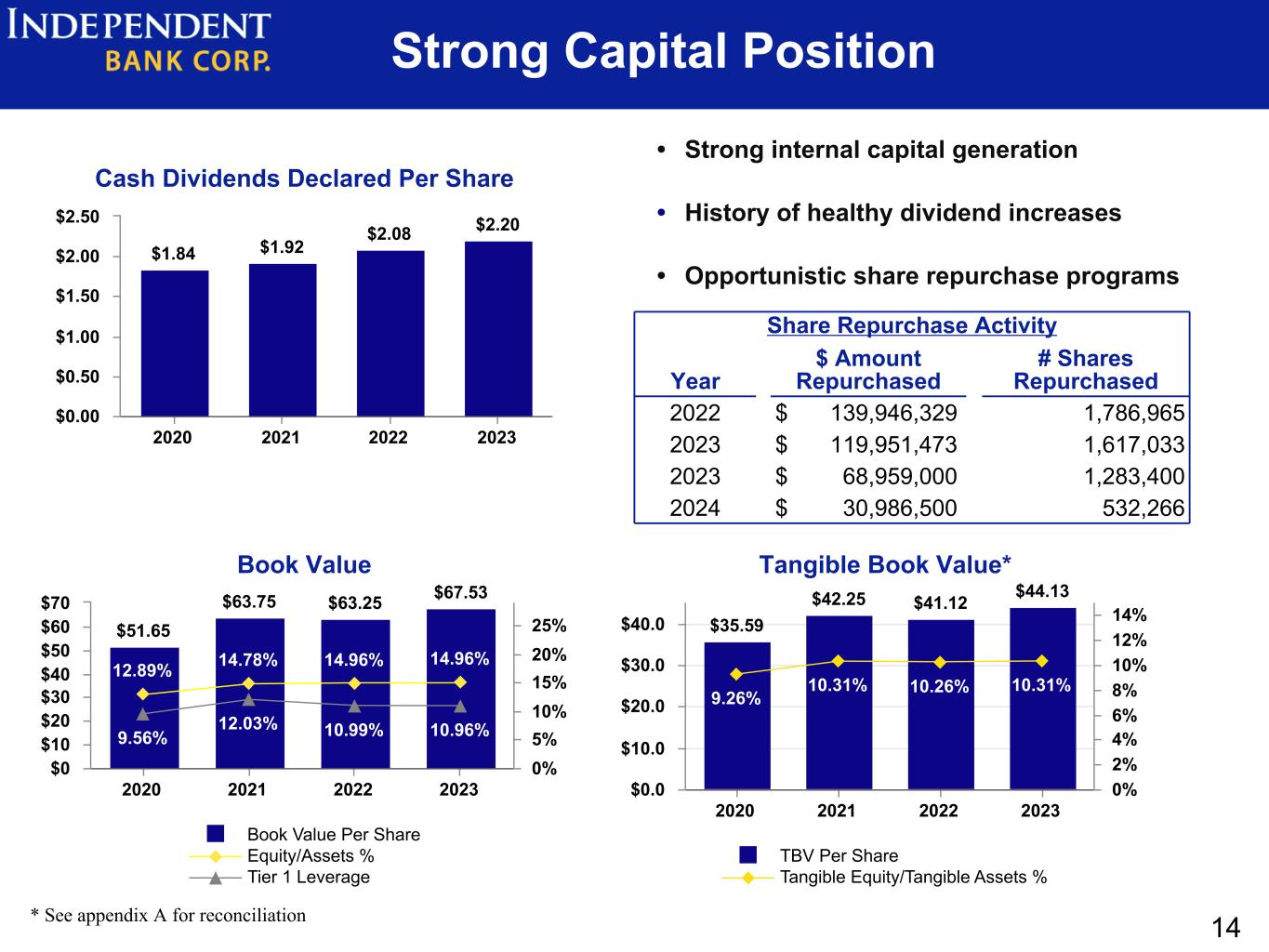
Book Value $51.65 $63.75 $63.25 $67.53 12.89% 14.78% 14.96% 14.96% 9.56% 12.03% 10.99% 10.96% Book Value Per Share Equity/Assets % Tier 1 Leverage 2020 2021 2022 2023 $0 $10 $20 $30 $40 $50 $60 $70 0% 5% 10% 15% 20% 25% Tangible Book Value* $35.59 $42.25 $41.12 $44.13 9.26% 10.31% 10.26% 10.31% TBV Per Share Tangible Equity/Tangible Assets % 2020 2021 2022 2023 $0.0 $10.0 $20.0 $30.0 $40.0 0% 2% 4% 6% 8% 10% 12% 14% * See appendix A for reconciliation • Strong internal capital generation • History of healthy dividend increases • Opportunistic share repurchase programs Cash Dividends Declared Per Share $1.84 $1.92 $2.08 $2.20 2020 2021 2022 2023 $0.00 $0.50 $1.00 $1.50 $2.00 $2.50 Strong Capital Position 14 Share Repurchase Activity Year $ Amount Repurchased # Shares Repurchased 2022 $ 139,946,329 1,786,965 2023 $ 119,951,473 1,617,033 2023 $ 68,959,000 1,283,400 2024 $ 30,986,500 532,266

15 Securities Portfolio Available for Sale (AFS) Held to Maturity (HTM) Portfolio Composition at December 31, 2023 Book Value Fair Value Unrealized Gain/(Loss) Book Value Fair Value Unrealized Gain/(Loss) ($ in millions) U.S. government agency securities $ 230 $ 207 $ (23) $ 30 $ 29 $ (1) U.S. treasury securities 825 769 (56) 101 92 (9) Agency mortgage-backed securities 314 277 (37) 829 763 (66) Agency collateralized mortgage obligations 36 33 (3) 478 408 (70) Other 55 48 (7) 131 126 (6) Total securities $ 1,460 $ 1,334 $ (126) $ 1,569 $ 1,418 $ (152) Duration of portfolio 3.3 Years 4.8 Years Capital Impact $ % of Tangible Assets ($ in millions) Tangible capital (Non-GAAP) $ 1,892 10.31 % Less: HTM unrealized loss, net of tax (109) Tangible capital adjusted for HTM $ 1,783 9.80 % ($ in m ill io ns ) Projected Cash Flows $373 $349 $593 2024 2025 2026 $0 $500 Securities as a % of Total Assets 16.2% 15.1% 14.4% 13.2% Q4 2022 Q4 2023 Q2 2024 Proforma Q4 2024 Proforma 12.5% 15.0% 17.5%
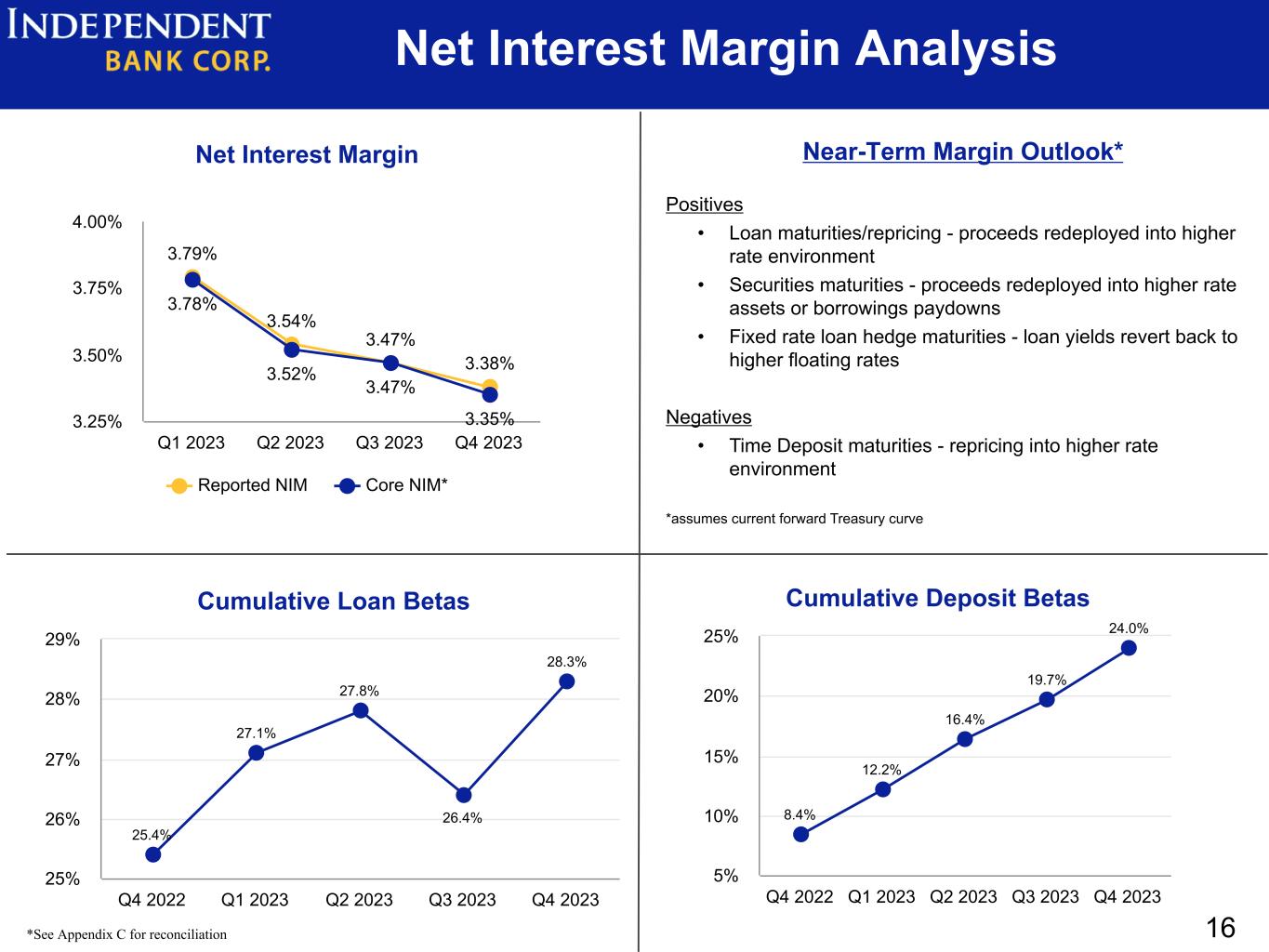
16 Net Interest Margin Analysis Net Interest Margin 3.79% 3.54% 3.47% 3.38% 3.78% 3.52% 3.47% 3.35% Reported NIM Core NIM* Q1 2023 Q2 2023 Q3 2023 Q4 2023 3.25% 3.50% 3.75% 4.00% Cumulative Loan Betas 25.4% 27.1% 27.8% 26.4% 28.3% Q4 2022 Q1 2023 Q2 2023 Q3 2023 Q4 2023 25% 26% 27% 28% 29% Cumulative Deposit Betas 8.4% 12.2% 16.4% 19.7% 24.0% Q4 2022 Q1 2023 Q2 2023 Q3 2023 Q4 2023 5% 10% 15% 20% 25% Near-Term Margin Outlook* Positives • Loan maturities/repricing - proceeds redeployed into higher rate environment • Securities maturities - proceeds redeployed into higher rate assets or borrowings paydowns • Fixed rate loan hedge maturities - loan yields revert back to higher floating rates Negatives • Time Deposit maturities - repricing into higher rate environment *assumes current forward Treasury curve *See Appendix C for reconciliation
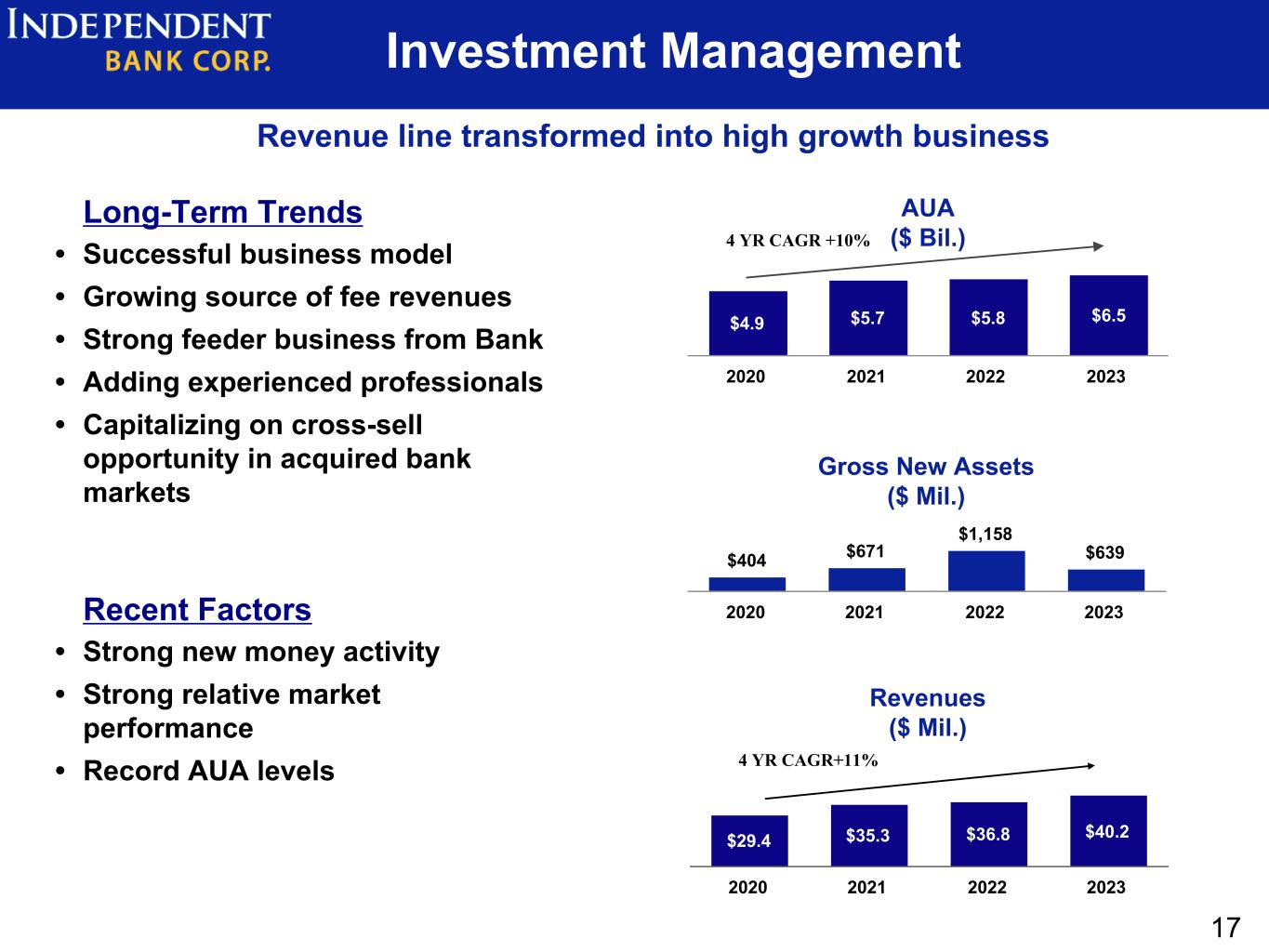
Investment Management Long-Term Trends • Successful business model • Growing source of fee revenues • Strong feeder business from Bank • Adding experienced professionals • Capitalizing on cross-sell opportunity in acquired bank markets AUA ($ Bil.) $4.9 $5.7 $5.8 $6.5 2020 2021 2022 2023 Revenues ($ Mil.) $29.4 $35.3 $36.8 $40.2 2020 2021 2022 2023 4 YR CAGR+11% Recent Factors • Strong new money activity • Strong relative market performance • Record AUA levels 4 YR CAGR +10% 17 Gross New Assets ($ Mil.) $404 $671 $1,158 $639 2020 2021 2022 2023 Revenue line transformed into high growth business
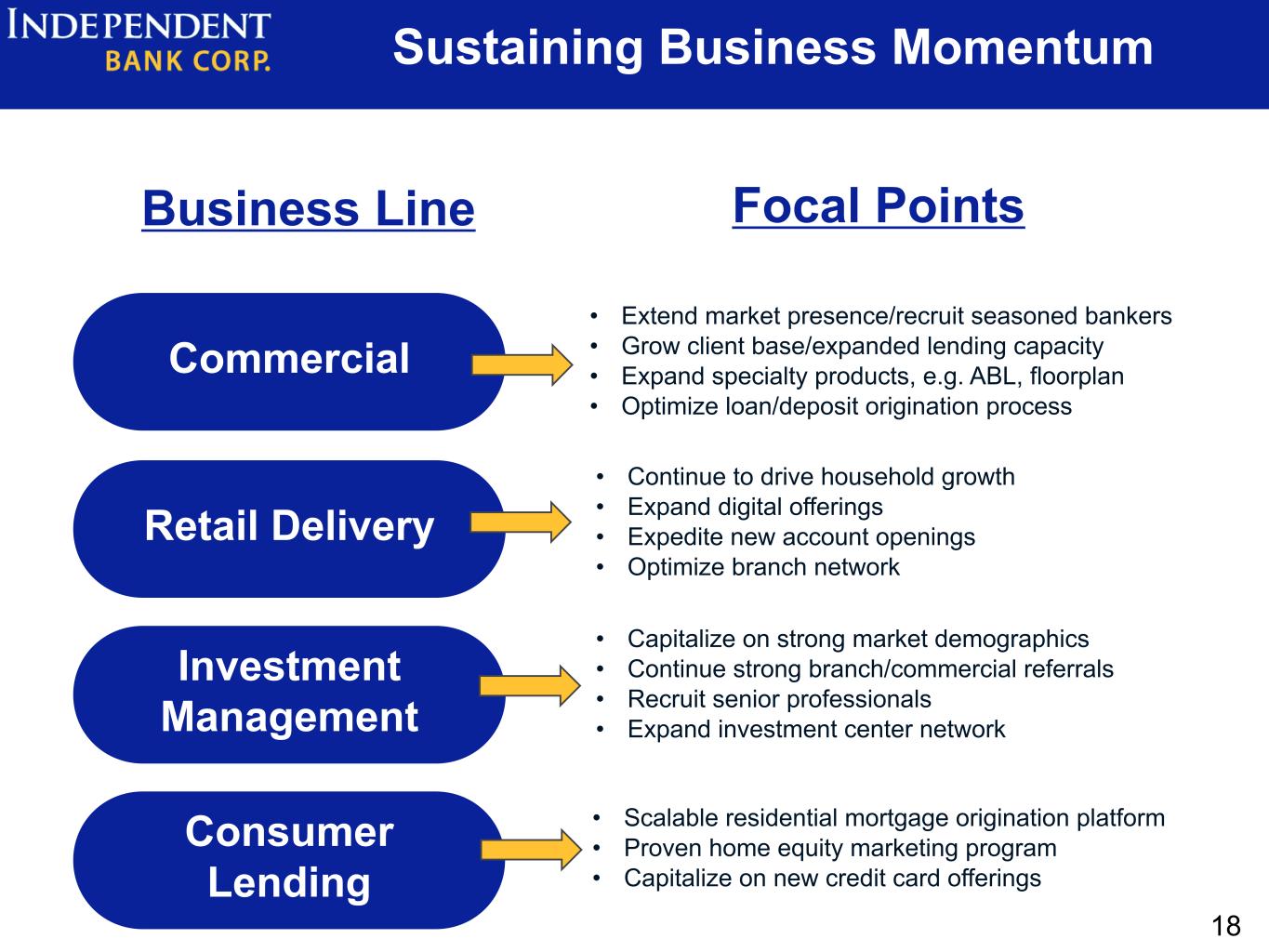
Sustaining Business Momentum Business Line • Extend market presence/recruit seasoned bankers • Grow client base/expanded lending capacity • Expand specialty products, e.g. ABL, floorplan • Optimize loan/deposit origination process • Continue to drive household growth • Expand digital offerings • Expedite new account openings • Optimize branch network • Capitalize on strong market demographics • Continue strong branch/commercial referrals • Recruit senior professionals • Expand investment center network • Scalable residential mortgage origination platform • Proven home equity marketing program • Capitalize on new credit card offerings Focal Points Commercialo ercial Retail Delivery Investment Management Consumer Lending 18

INDB Investment Merits • High quality franchise in attractive markets • Consistent, strong financial performance • Strong organic business volumes • Growing brand recognition • Leverageable operating platform • Capitalizing on in-market consolidation opportunities • Diligent stewards of shareholder capital • Grounded management team 19 Positioned to grow, build, and acquire to drive long-term value creation
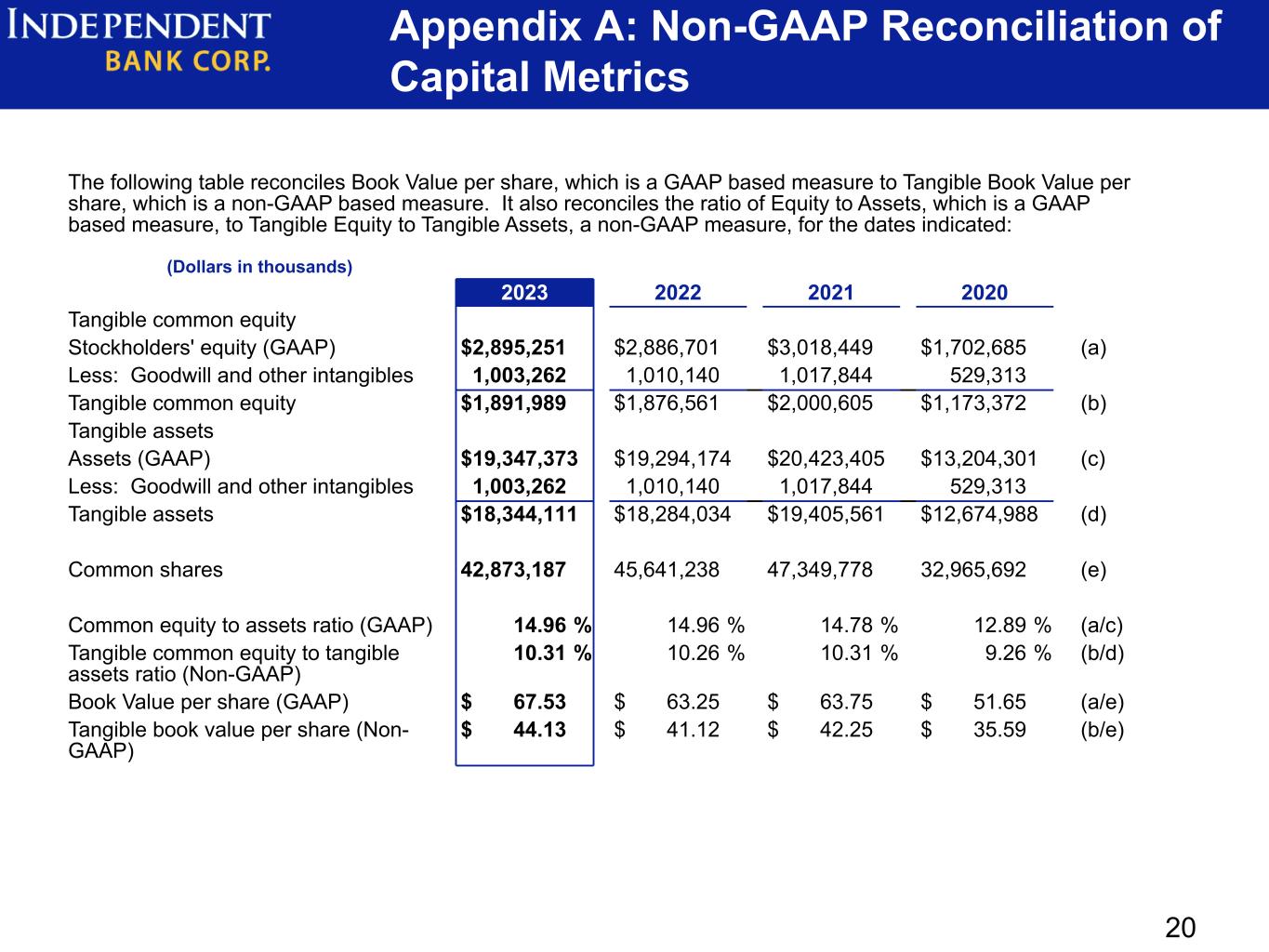
Appendix A: Non-GAAP Reconciliation of Capital Metrics The following table reconciles Book Value per share, which is a GAAP based measure to Tangible Book Value per share, which is a non-GAAP based measure. It also reconciles the ratio of Equity to Assets, which is a GAAP based measure, to Tangible Equity to Tangible Assets, a non-GAAP measure, for the dates indicated: (Dollars in thousands) 2023 2022 2021 2020 Tangible common equity Stockholders' equity (GAAP) $ 2,895,251 $ 2,886,701 $ 3,018,449 $ 1,702,685 (a) Less: Goodwill and other intangibles 1,003,262 1,010,140 1,017,844 529,313 Tangible common equity $ 1,891,989 $ 1,876,561 $ 2,000,605 $ 1,173,372 (b) Tangible assets Assets (GAAP) $ 19,347,373 $ 19,294,174 $ 20,423,405 $ 13,204,301 (c) Less: Goodwill and other intangibles 1,003,262 1,010,140 1,017,844 529,313 Tangible assets $ 18,344,111 $ 18,284,034 $ 19,405,561 $ 12,674,988 (d) Common shares 42,873,187 45,641,238 47,349,778 32,965,692 (e) Common equity to assets ratio (GAAP) 14.96 % 14.96 % 14.78 % 12.89 % (a/c) Tangible common equity to tangible assets ratio (Non-GAAP) 10.31 % 10.26 % 10.31 % 9.26 % (b/d) Book Value per share (GAAP) $ 67.53 $ 63.25 $ 63.75 $ 51.65 (a/e) Tangible book value per share (Non- GAAP) $ 44.13 $ 41.12 $ 42.25 $ 35.59 (b/e) 20
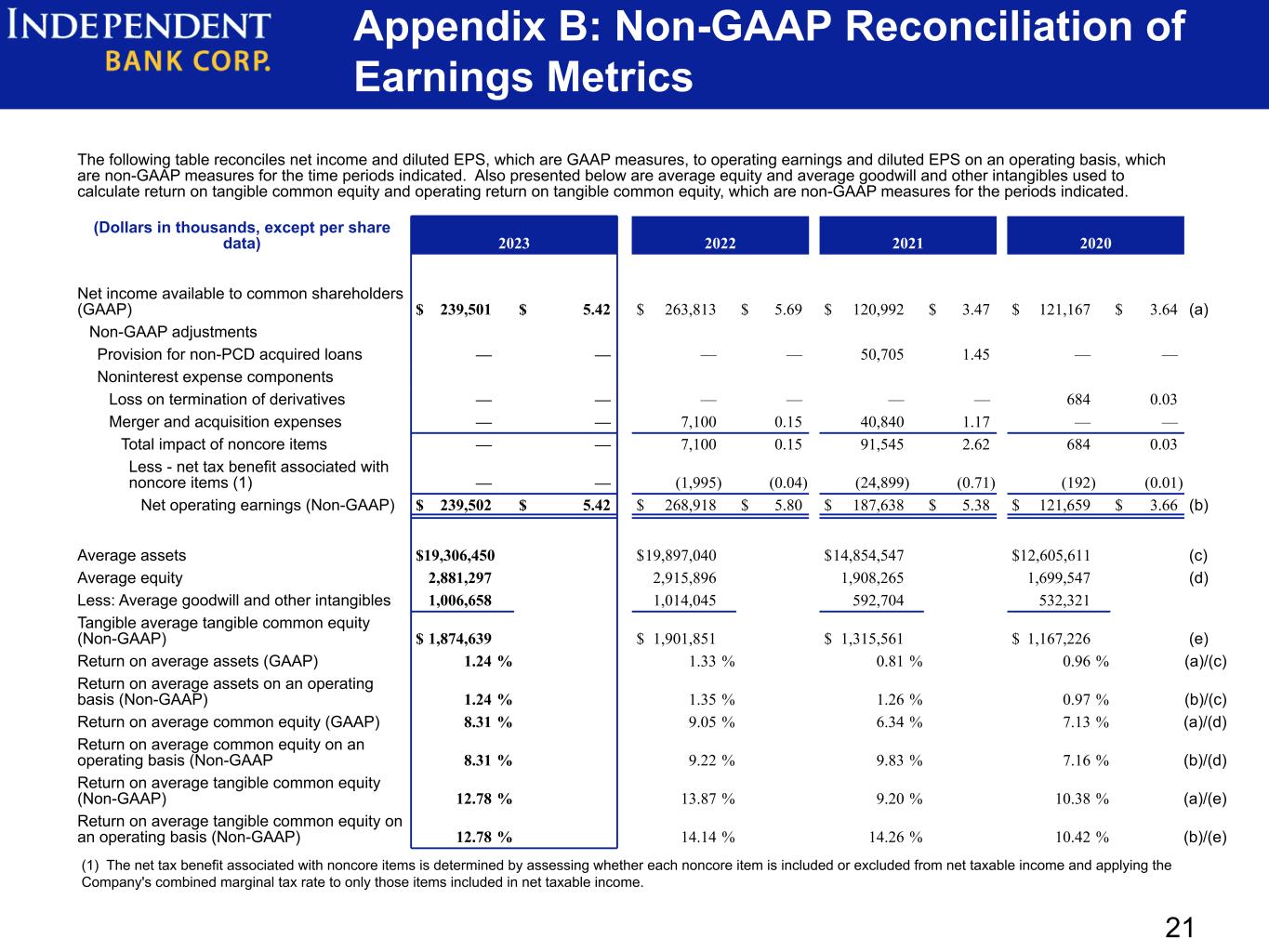
Appendix B: Non-GAAP Reconciliation of Earnings Metrics The following table reconciles net income and diluted EPS, which are GAAP measures, to operating earnings and diluted EPS on an operating basis, which are non-GAAP measures for the time periods indicated. Also presented below are average equity and average goodwill and other intangibles used to calculate return on tangible common equity and operating return on tangible common equity, which are non-GAAP measures for the periods indicated. (Dollars in thousands, except per share data) 2023 2022 2021 2020 Net income available to common shareholders (GAAP) $ 239,501 $ 5.42 $ 263,813 $ 5.69 $ 120,992 $ 3.47 $ 121,167 $ 3.64 (a) Non-GAAP adjustments Provision for non-PCD acquired loans — — — — 50,705 1.45 — — Noninterest expense components Loss on termination of derivatives — — — — — — 684 0.03 Merger and acquisition expenses — — 7,100 0.15 40,840 1.17 — — Total impact of noncore items — — 7,100 0.15 91,545 2.62 684 0.03 Less - net tax benefit associated with noncore items (1) — — (1,995) (0.04) (24,899) (0.71) (192) (0.01) Net operating earnings (Non-GAAP) $ 239,502 $ 5.42 $ 268,918 $ 5.80 $ 187,638 $ 5.38 $ 121,659 $ 3.66 (b) Average assets $ 19,306,450 $ 19,897,040 $ 14,854,547 $ 12,605,611 (c) Average equity 2,881,297 2,915,896 1,908,265 1,699,547 (d) Less: Average goodwill and other intangibles 1,006,658 1,014,045 592,704 532,321 Tangible average tangible common equity (Non-GAAP) $ 1,874,639 $ 1,901,851 $ 1,315,561 $ 1,167,226 (e) Return on average assets (GAAP) 1.24 % 1.33 % 0.81 % 0.96 % (a)/(c) Return on average assets on an operating basis (Non-GAAP) 1.24 % 1.35 % 1.26 % 0.97 % (b)/(c) Return on average common equity (GAAP) 8.31 % 9.05 % 6.34 % 7.13 % (a)/(d) Return on average common equity on an operating basis (Non-GAAP 8.31 % 9.22 % 9.83 % 7.16 % (b)/(d) Return on average tangible common equity (Non-GAAP) 12.78 % 13.87 % 9.20 % 10.38 % (a)/(e) Return on average tangible common equity on an operating basis (Non-GAAP) 12.78 % 14.14 % 14.26 % 10.42 % (b)/(e) (1) The net tax benefit associated with noncore items is determined by assessing whether each noncore item is included or excluded from net taxable income and applying the Company's combined marginal tax rate to only those items included in net taxable income. 21
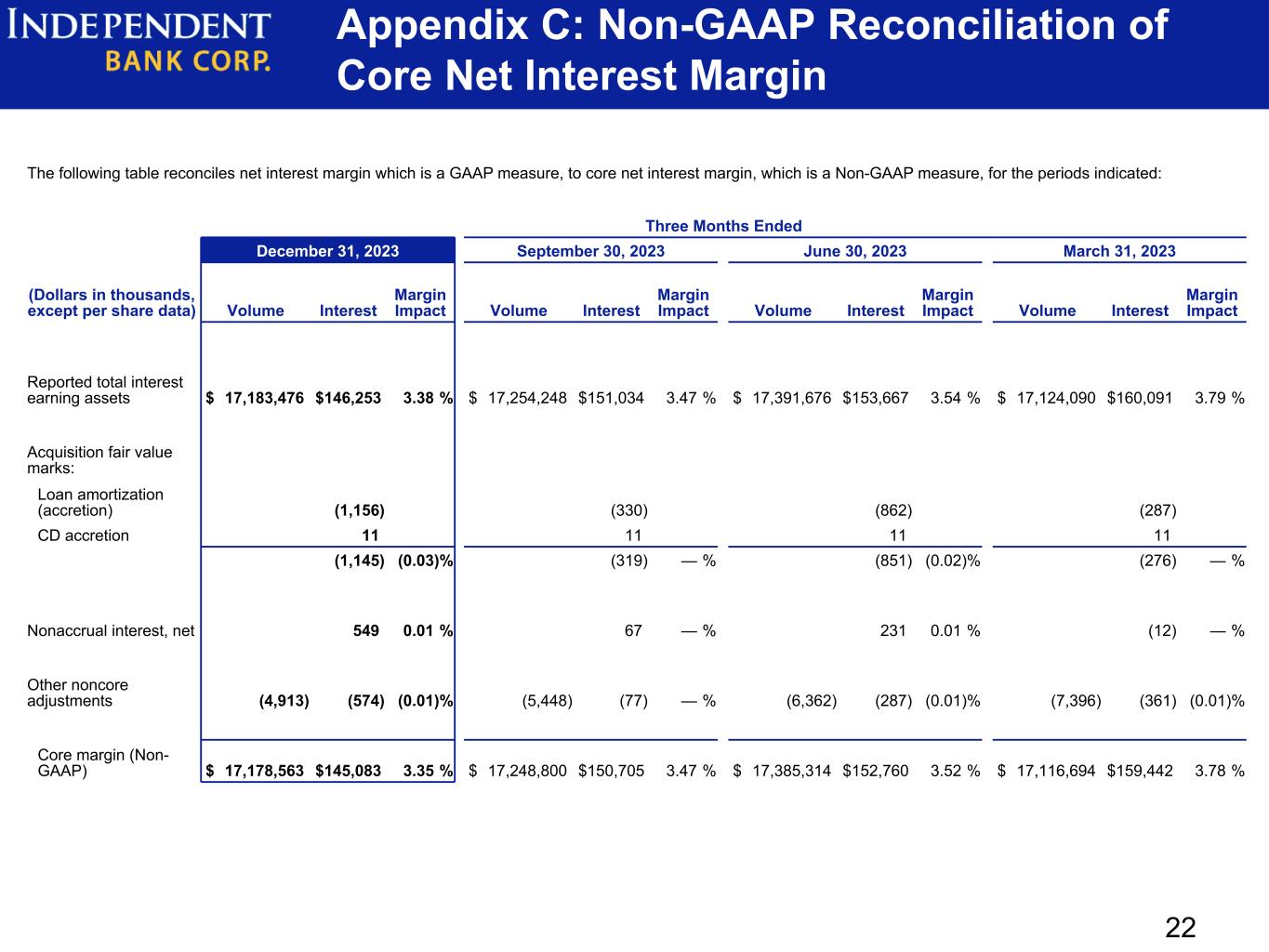
Appendix C: Non-GAAP Reconciliation of Core Net Interest Margin The following table reconciles net interest margin which is a GAAP measure, to core net interest margin, which is a Non-GAAP measure, for the periods indicated: Three Months Ended December 31, 2023 September 30, 2023 June 30, 2023 March 31, 2023 (Dollars in thousands, except per share data) Volume Interest Margin Impact Volume Interest Margin Impact Volume Interest Margin Impact Volume Interest Margin Impact Reported total interest earning assets $ 17,183,476 $ 146,253 3.38 % $ 17,254,248 $ 151,034 3.47 % $ 17,391,676 $ 153,667 3.54 % $ 17,124,090 $ 160,091 3.79 % Acquisition fair value marks: Loan amortization (accretion) (1,156) (330) (862) (287) CD accretion 11 11 11 11 (1,145) (0.03) % (319) — % (851) (0.02) % (276) — % Nonaccrual interest, net 549 0.01 % 67 — % 231 0.01 % (12) — % Other noncore adjustments (4,913) (574) (0.01) % (5,448) (77) — % (6,362) (287) (0.01) % (7,396) (361) (0.01) % Core margin (Non- GAAP) $ 17,178,563 $ 145,083 3.35 % $ 17,248,800 $ 150,705 3.47 % $ 17,385,314 $ 152,760 3.52 % $ 17,116,694 $ 159,442 3.78 % 22

This presentation contains certain “forward-looking statements” within the meaning of the Private Securities Litigation Reform Act of 1995 with respect to the financial condition, results of operations and business of the Company. These statements may be identified by such forward-looking terminology as “expect,” “achieve,” “plan,” “believe,” “outlook”, “projected”, “future,” “positioned,” “continued,” “will,” “would,” “potential,” “anticipated,” “guidance,” “targeted” or similar statements or variations of such terms. Actual results may differ from those contemplated by these forward-looking statements. Factors that may cause actual results to differ materially from those contemplated by such forward-looking statements include, but are not limited to: • further weakening in the United States economy in general and the regional and local economies within the New England region and the Company’s market area; • the effects to the Company or its customers of inflationary pressures, labor market shortages and supply chain issues; • the instability or volatility in financial markets and unfavorable general economic or business conditions, globally, nationally or regionally, whether caused by geopolitical concerns, including the Russia/Ukraine conflict, the conflict in Israel and surrounding areas and the possible expansion of such conflicts, recent disruptions in the banking industry, or other factors, and the potential impact of unfavorable economic conditions on the Company and its customers, including the potential for decreases in deposits and loan demand, unanticipated loan delinquencies, loss of collateral and decreased service revenues; • unanticipated loan delinquencies, loss of collateral, decreased service revenues, and other potential negative effects on our business caused by severe weather, pandemics or other external events; • adverse changes or volatility in the local real estate market; • rising interest rates and any resultant adverse changes in asset quality, increased credit risks, decreased loan demand, and/or financing challenges, which in turn could further lead to unanticipated credit deterioration in the Company's loan portfolio, including with respect to one or more large commercial relationships; • acquisitions may not produce results at levels or within time frames originally anticipated and may result in unforeseen integration issues or impairment of goodwill and/or other intangibles; • additional regulatory oversight and related compliance costs; • changes in trade, monetary and fiscal policies and laws, including interest rate policies of the Board of Governors of the Federal Reserve System; • higher than expected tax expense, including as a result of failure to comply with general tax laws and changes in tax laws; • changes in market interest rates for interest earning assets and/or interest bearing liabilities; • increased competition in the Company’s market areas, including competition that could impact deposit gathering, retention of deposits and the cost of deposits, increased competition due to the demand for innovative products and service offerings, and competition form non-depository institutions which may be subject to fewer regulatory constraints and lower cost structures; • adverse weather, changes in climate, natural disasters, including the risk of floods and fire; the emergence of widespread health emergencies or pandemics, any further resurgences or variants of the "COVID-19 virus", actions taken by governmental authorities in response thereto, other public health crises or man-made events, and their impact on the Company's local economies or the Company's operations; • a deterioration in the conditions of the securities markets; • a deterioration of the credit rating for U.S. long-term sovereign debt or uncertainties surrounding the federal budget; • inability to adapt to changes in information technology, including changes to industry accepted delivery models driven by a migration to the internet as a means of service delivery; • electronic or other fraudulent activity within the financial services industry, especially in the commercial banking sector; • adverse changes in consumer spending and savings habits; • the effect of laws and regulations regarding the financial services industry, including the need to invest in technology to meet heightened regulatory expectations or introduction of new requirements or expectations resulting in increased costs of compliance or required adjustments to strategy; • changes in laws and regulations (including laws and regulations concerning taxes, banking, securities and insurance) generally applicable to the Company’s business, including any such changes in laws and regulations as a result of recent disruptions in the banking industry, and the associated costs of such changes; • the Company's potential judgments, claims, damages, penalties, fines and reputational damage resulting from pending or future litigation and regulatory and government actions; • changes in accounting policies, practices and standards, as may be adopted by the regulatory agencies as well as the Public Company Accounting Oversight Board, the Financial Accounting Standards Board, and other accounting standard setters; • operational risks related to cyber threats, attacks, intrusions and fraud which could lead to interruptions or disruptions of the Company's operating systems, including systems that are customer facing, and adversely impact our business; and • other unexpected material adverse changes in our operations or earnings. The Company wishes to caution readers not to place undue reliance on any forward-looking statements as the Company’s business and its forward-looking statements involve substantial known and unknown risks and uncertainties described in the Company’s Annual Report on Form 10-K and subsequent Quarterly Reports on Form 10-Q (“Risk Factors”). Except as required by law, the Company disclaims any intent or obligation to update publicly any such forward-looking statements, whether in response to new information, future events or otherwise. Any public statements or disclosures by the Company following this presentation which modify or impact any of the forward-looking statements contained in this presentation will be deemed to modify or supersede such statements in this presentation. In addition to the information set forth in this presentation, you should carefully consider the Risk Factors. 23 Forward Looking Statements
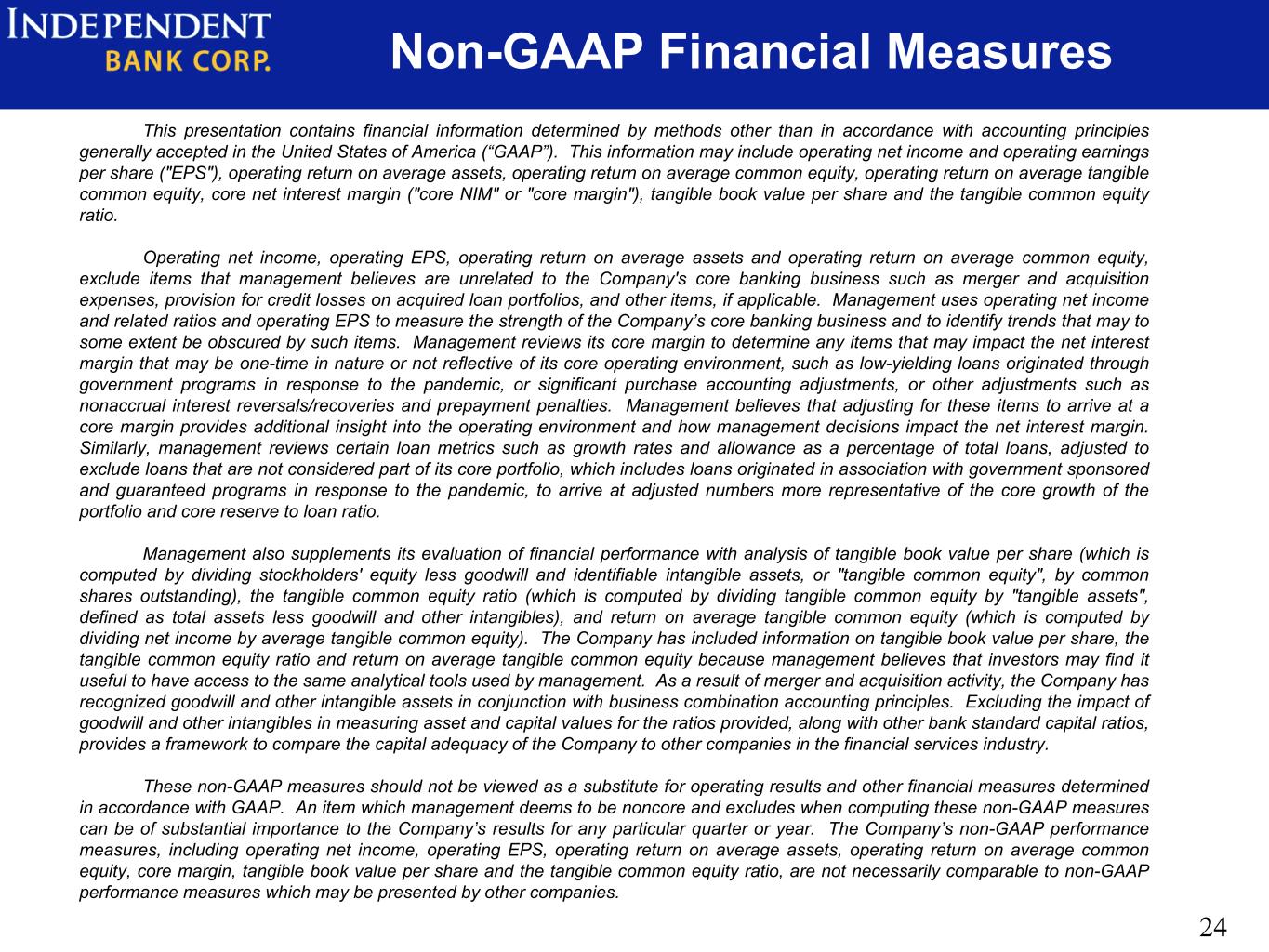
This presentation contains financial information determined by methods other than in accordance with accounting principles generally accepted in the United States of America (“GAAP”). This information may include operating net income and operating earnings per share ("EPS"), operating return on average assets, operating return on average common equity, operating return on average tangible common equity, core net interest margin ("core NIM" or "core margin"), tangible book value per share and the tangible common equity ratio. Operating net income, operating EPS, operating return on average assets and operating return on average common equity, exclude items that management believes are unrelated to the Company's core banking business such as merger and acquisition expenses, provision for credit losses on acquired loan portfolios, and other items, if applicable. Management uses operating net income and related ratios and operating EPS to measure the strength of the Company’s core banking business and to identify trends that may to some extent be obscured by such items. Management reviews its core margin to determine any items that may impact the net interest margin that may be one-time in nature or not reflective of its core operating environment, such as low-yielding loans originated through government programs in response to the pandemic, or significant purchase accounting adjustments, or other adjustments such as nonaccrual interest reversals/recoveries and prepayment penalties. Management believes that adjusting for these items to arrive at a core margin provides additional insight into the operating environment and how management decisions impact the net interest margin. Similarly, management reviews certain loan metrics such as growth rates and allowance as a percentage of total loans, adjusted to exclude loans that are not considered part of its core portfolio, which includes loans originated in association with government sponsored and guaranteed programs in response to the pandemic, to arrive at adjusted numbers more representative of the core growth of the portfolio and core reserve to loan ratio. Management also supplements its evaluation of financial performance with analysis of tangible book value per share (which is computed by dividing stockholders' equity less goodwill and identifiable intangible assets, or "tangible common equity", by common shares outstanding), the tangible common equity ratio (which is computed by dividing tangible common equity by "tangible assets", defined as total assets less goodwill and other intangibles), and return on average tangible common equity (which is computed by dividing net income by average tangible common equity). The Company has included information on tangible book value per share, the tangible common equity ratio and return on average tangible common equity because management believes that investors may find it useful to have access to the same analytical tools used by management. As a result of merger and acquisition activity, the Company has recognized goodwill and other intangible assets in conjunction with business combination accounting principles. Excluding the impact of goodwill and other intangibles in measuring asset and capital values for the ratios provided, along with other bank standard capital ratios, provides a framework to compare the capital adequacy of the Company to other companies in the financial services industry. These non-GAAP measures should not be viewed as a substitute for operating results and other financial measures determined in accordance with GAAP. An item which management deems to be noncore and excludes when computing these non-GAAP measures can be of substantial importance to the Company’s results for any particular quarter or year. The Company’s non-GAAP performance measures, including operating net income, operating EPS, operating return on average assets, operating return on average common equity, core margin, tangible book value per share and the tangible common equity ratio, are not necessarily comparable to non-GAAP performance measures which may be presented by other companies. 24 Non-GAAP Financial Measures